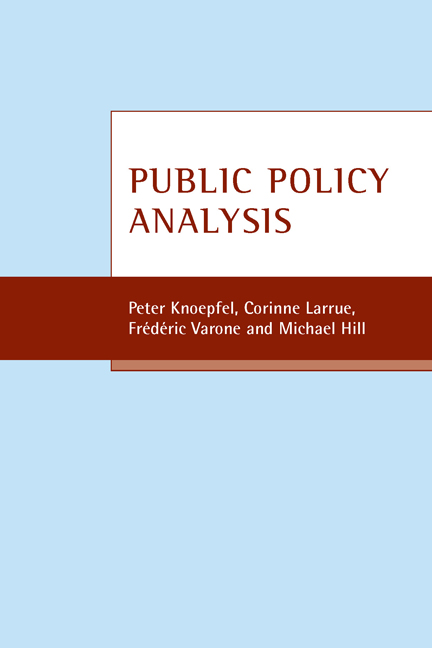eleven - Research and working hypotheses
Published online by Cambridge University Press: 14 January 2022
Summary
This chapter recapitulates the main analytical dimensions previously identified for the definition of the six products of a public policy found in political-administrative and social reality (see Chapters Seven to Ten). In this context, particular emphasis is placed on the complementary nature of the substantive and institutional content of these products. Based on this synoptic view, we will now present three possible ‘access points’ for the formulation of working hypotheses to be tested in the course of an empirical analysis of the explanatory factors behind these six policy products. In doing this, we make direct reference to the logic of the analysis model (Chapter Six) and to the basic elements (actors, resources and institutions) on which our public policy approach, which is inspired by actor-centred institutionalism, is based (Chapters Two to Five).
In a nutshell, we will attempt to explain the six products of a public policy as a function of the strategies of public and private actors, the resources that they mobilise to assert their rights and interests and the constraints or opportunities placed on them by institutional rules – both general and specific to the area being studied. Thus, this chapter formulates hypotheses on the (causal) links that potentially exist between the policy products (variables to be explained) and the ‘games’ played by the actors who compose the basic triangle (explanatory variables).
The proposed analytical model may be applied from different scientific perspectives, that is, to describe, interpret, explain or anticipate the content of a policy. Table 11.1 demonstrates the potential utility of the model in terms of these analytical levels. This chapter concentrates on the formulation of research and working hypotheses that facilitate the development of empirical research based on an explanatory perspective.
11.1 Variables to be explained: the substantive and institutional dimensions of policy products
Table 11.2 presents the six products that the analyst can define in the course of a policy cycle as a function of multiple material supports (for example, government programmes, legislation and regulations, annual reports of administrative services, expert evaluations, informal documents produced by the administration and interest groups, syntheses of consultation or negotiation processes, print media, websites).
Beyond the generic definition of these six products, Table 11.2 lists the operational dimensions presented earlier by way of illustration for the detailed study of their constituent elements.
- Type
- Chapter
- Information
- Public Policy Analysis , pp. 251 - 272Publisher: Bristol University PressPrint publication year: 2007



